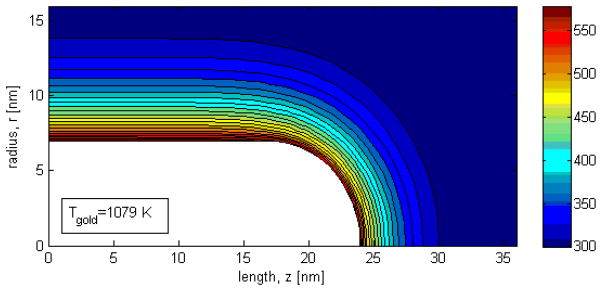Thermal analysis of gold nanorods heated with femtosecond laser pulses
Ekici O, Harrison RK, Durr NJ, Eversole DS, Lee M, Ben-Yakar A.
J Phys D-Appl Phys 41:18 185501 2008.
DOI: 10.1088/0022-3727/41/18/185501
We present an axisymmetric computational model to study the heating processes of gold nanoparticles, specifically nanorods, in aqueous medium by femtosecond laser pulses. We use a two-temperature model for the particle, a heat diffusion equation for the surrounding water to describe the heat transfer processes occurring in the system, and a thermal interface conductance to describe the coupling efficiency at the particle/water interface. We investigate the characteristic time scales of various fundamental processes, including lattice heating and thermal equilibration at the particle/surroundings interface, the effects of multiple laser pulses, and the influence of nanorod orientation relative to the beam polarization on energy absorption. Our results indicate that the thermal equilibration at the particle/water interface takes approximately 500 ps, while the electron–lattice coupling is achieved at approximately 50 ps when a 48 × 14 nm2 gold nanorod is heated to a maximum temperature of 1270 K with the application of a laser pulse having 4.70 J m−2 average fluence. Irradiation by multiple pulses arriving at 12.5 ns time intervals (80 MHz repetition rate) causes a temperature increase of no more than 3 °C during the first few pulses with no substantial changes during the subsequent pulses. We also analyse the degree of the nanorods’ heating as a function of their orientation with respect to the polarization of the incident light. Lastly, it is shown that the temperature change of a nanorod can be modelled using its volume-equivalent sphere for femtosecond laser heating within 5–15% accuracy.
